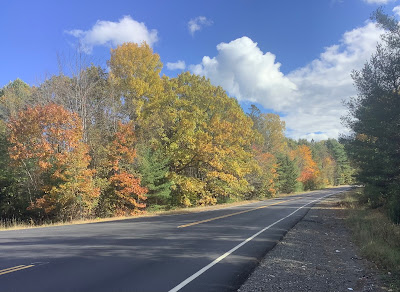The hilly terrain of central Maine dished up the most climbing of any day of the first fifteen of these travels—4,362 feet in seventy-one miles, just the third day of over four thousand feet. But the day after all the hills the terrain leveled somewhat and I managed the second eighty-mile day since I set out. Mileage is becoming important as I seek to reach Sydney before the weather gets too nasty, six hundred miles away, at the far tip of Nova Scotia, where two Carnegie Libraries await me, the only two in the province. There is another in New Brunswick that I’ll drop in on the way back to Maine.
I may get my first rest day this weekend, as I’ve had warnings of a significant storm bearing down on the coast. I first learned of it from a checkout woman at a Dollar Store and then from Michael Lombardi’s football podcast, as he said rainy and windy conditions could keep the scoring down in games played on the east coast this Sunday.
So far wind hasn’t been a factor in my first thousand miles, just all the climbing and a few stretches of dirt. The cool, mostly dank weather has limited those cycling to just about me. I was very fortunate that Greg back in Vermont was out on his bike late in the day and could provide me directions to Ian Boswell’s remote homestead.
A plaque in front of the library celebrated the local volunteer fire department, which was based behind the library. With wooden buildings dominating the town and surrounding area, fires had been a concern since the town’s origin. One of its first communal expenditures was for hooks and buckets and ladders for its fire brigade in 1871. Twelve years later the town purchased a steam-powered pumping engine. They later excavated an huge hole for a tank to store water to pump. Even as its equipment improved over the years, the fire department remained staffed by volunteers, a great point of pride. The plaque concluded its tribute saying, “The volunteer fire department has remained a key element of public safety where the spirit of independence and self-reliance has led people to depend on their own resources.”
Earlier in the day I came upon a stash of coins strewn along the road, including six quarters, doubling the number I’ve found so far. When I first spotted the coins I figured they had to be slugs, but no they were all coins, including nine dimes, five nickels and eleven pennies. I didn’t count them at the time, looking forward to totaling up my haul in the tent. I also stopped for a bright orange wash cloth tangled in the weeds, which I could use to sop up moisture in my tent left over from a morning dew or rain and also to strap on the back of my bike to make me more visible. It took a full day for it to dry though after I washed it, even dangling in the wind from the crossbar of my bike.








No comments:
Post a Comment